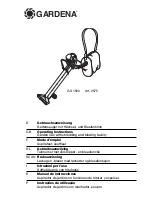
Troubleshooting
Problem
Possible Cause
Remedy
The vacuum pump does not reach the usual
pressure
The drive motor draws a too high current
(compare with initial value after
commissioning)
Evacuation of the system takes too long
The vacuum system or suction line is not leak-
tight
Check the hose or pipe connections for
possible leak
In case a vacuum relief valve/regulating
system is installed:
The vacuum relief valve/regulating system is
misadjusted or defective
Adjust, repair or replace, respectively
The screen (715) in the suction connection
(g/p) is partially clogged
Clean the screen (715)
If cleaning is required too frequently install a
filter upstream
In case a filter (h) is installed on the suction
connection (g/p):
The filter (h) on the suction connection (g/p)
is partially clogged
Clean or replace the inlet air filter (h),
respectively
Partial clogging in the suction, discharge or
pressure line
Remove the clogging
Long suction, discharge or pressure line with
too small diameter
Use larger diameter
The valve disk of the inlet non-return valve is
stuck in closed or partially open position
Disassemble the inlet, clean the screen (715)
and the valve (o, 714) as required and
reassemble
The gas conveyed by the vacuum pump
smells displeasing
Process components evaporating under
vacuum
Check the process, if applicable
The vacuum pump does not start
The drive motor is not supplied with the
correct voltage or is overloaded
Supply the drive motor with the correct voltage
The drive motor starter overload protection is
too small or trip level is too low
Compare the trip level of the drive motor
starter overload protection with the data on the
nameplate, correct if necessary
In case of high ambient temperature: set the
trip level of the drive motor starter overload
protection 5 percent above the nominal drive
motor current
One of the fuses has blown
Check the fuses
The connection cable is too small or too long
causing a voltage drop at the vacuum pump
Use sufficiently dimensioned cable
CAUTION
During operation the surface of the vacuum pump may reach temperatures of more than 70 °C.
Risk of burns!
Let the vacuum pump cool down prior to a required contact or wear heat protection gloves.
WARNING
Risk of electrical shock, risk of damage to equipment.
Electrical installation work must only be executed by qualified personnel that knows and observes the following regulations:
- IEC 364 or CENELEC HD 384 or DIN VDE 0100, respectively,
- IEC-Report 664 or DIN VDE 0110,
- BGV A2 (VBG 4) or corresponding national accident prevention regulation.
Seite
12
30.30.01.00867-00_EN / 04.2015
Internal parts are worn or damaged
Repair the vacuum pump (
Schmalz
service)
Troubleshooting
EVE-KL
Summary of Contents for EVE-KL
Page 1: ...Innovative Vacuum for Automation EN 30 30 01 00867 00 04 2015 Operating Instructions EVE KL ...
Page 15: ...Sectional Drawing 30 30 01 00867 00_EN 04 2015 Seite 15 EVE KL Sectional Drawing ...
Page 17: ...30 30 01 00867 00_EN 04 2015 Seite 17 EVE KL EC Declaration of Conformity ...
Page 19: ...30 30 01 00867 00_EN 04 2015 Seite 19 EVE KL blank page ...






































